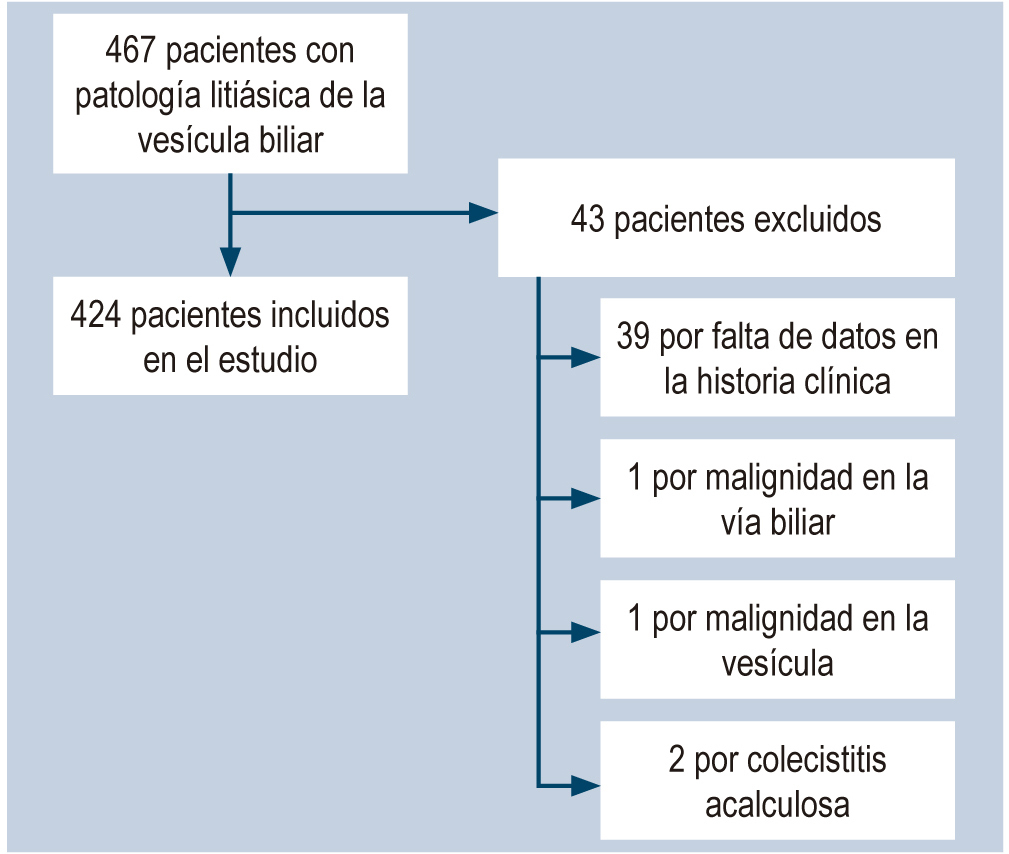Are the ASGE criteria sufficient to stratify the risk of choledocholithiasis?
DOI:
https://doi.org/10.22516/25007440.464Keywords:
Choledocholithiasis, Choledocholithiasis risk, ASGE criteria, CholecystitisAbstract
Introduction: Biliary lithiasis is one of the most frequent diseases in the area of general surgery and gastroenterology. Treatment varies depending on the location of the gallstones. Several stratification scales of the risk of choledocholithiasis have been defined, being the criteria proposed by the American Society of Gastrointestinal Endoscopy (ASGE) the most used worldwide, with a diagnostic accuracy of 70%. However, the procedures or diagnostic aids defined by these criteria, sometimes, increase hospital stay, costs, and may lead to the development of complications.
Methodology: An observational, analytical, retrospective, cross-sectional study was conducted with data obtained from the clinical records of patients undergoing laparoscopic cholecystectomy at the CES Clinic in Medellín, Colombia, between July and December of 2017.
Results and conclusions: 424 medical records were analyzed, of which 254 (56.76%) were classified as low-risk, 94 (22.11%) as intermediate-risk and 76 (17.88%) as high-risk. The frequency of choledocholithiasis was 90.8% in high-risk patients and 26.6% in intermediate-risk patients. For the intermediate-risk category, statistically significant differences were found between the two groups for the total bilirubin, direct bilirubin, and AST values (p: 0.001, p: 0.014, p:0.007, respectively). The low frequency of choledocholithiasis in the intermediate-risk category can be explained by less than 5mm gallstones not identified by the cholangioresonance. Based on this study, we propose to adjust the ranges of the ASGE criteria variables for the intermediate-risk category for better accuracy when classifying patients with biliary lithiasis and, thus, reduce costs and hospital stay.
Downloads
References
Quintanilla C, Flisfisch H. Coledocolitiasis. Rev Medicina y Humanidades. 2009;1(3):160-168.
Oblitas NM. Pruebas de laboratorio como predictores de coledocolitiasis en pacientes sometidos a CPRE en un hospital nacional de referencia. Lima: Facultad de Medicina, Universidad Nacional Mayor de San Marcos; 2015.
Almora CL, Arteaga Y, Plaza T, Prieto Y, Hernández Z. Diagnóstico clínico y epidemiológico de la litiasis vesicular. Revisión bibliográfica. Rev Ciencias Médicas. 2012;16(1):200-214.
Wilkins T, Agabin E, Varghese J, Talukder A. Gallbladder Dysfunction: Cholecystitis, Choledocholithiasis, Cholangitis, and Biliary Dyskinesia. Prim Care. 2017;44(4):575-597.
http://doi.org/10.1016/j.pop.2017.07.002
Gómez M, Pion J, Otero W. Predictores de coledocolitiasis en pacientes sometidos a colangiografía retrógrada endoscópica en el Hospital El Tunal de Bogotá. Rev Col Gastroenterol. 2011;26(4):243-252.
ASGE Standards of Practice Committee, Maple JT, Ben-Menachem T, Anderson MA, Appalaneni V, Banerjee S, Cash BD, Fisher L, Harrison ME, Fanelli RD, Fukami N, Ikenberry SO, Jain R, Khan K, Krinsky ML, Strohmeyer L, Dominitz JA.. The role of endoscopy in the evaluation of suspected choledocholithiasis. Gastrointest Endosc. 2010;71(1):1-9.
http://doi.org/10.1016/j.gie.2009.09.041
Abuhadba NE. Asociación entre predictores de coledocolitiasis diagnosticada por colangiografía intraoperatoria en el Hospital Nacional Arzobispo Loayza. Lima: Universidad de San Martín de Porres; 2016.
Sethi S, Wang F, Korson AS, Krishnan S, Berzin TM, Chuttani R, Pleskow DK, Sawhney MS. Prospective assessment of consensus criteria for evaluation of patients with suspected choledocholithiasis. Dig Endosc. 2016;28(1):75-82.
http://doi.org/10.1111/den.12506
Sethi S, Krishnan S, Korson AS, Chuttani R, Pleskow DK, Berzin TM, Cury M, Wang F, Sawhney M, Whadhwa V. Prospective validation of ASGE criteria for the evaluation of suspected choledocholithiasis [abstract]. J Gastroenterol Hepatol. 2013;28 Suppl 3:18.
Rubin MI, Thosani NC, Tanikella R, Wolf DS, Fallon MB, Lukens FJ. Endoscopic retrograde cholangiopancreatography for suspected choledocholithiasis: testing the current guidelines. Dig Liver Dis. 2013;45(9):744-749.
http://doi.org/10.1016/j.dld.2013.02.005
Magalhães J, Rosa B, Cotter J. Endoscopic retrograde cholangiopancreatography for suspected choledocholithiasis: From guidelines to clinical practice. World J Gastrointest Endosc. 2015;7(2):128-134.
http://doi.org/10.4253/wjge.v7.i2.128
Al-Jiffry BO, Elfateh A, Chundrigar T, Othman B, Almalki O, Rayza F, Niyaz H, Elmakhzangy H, Hatem M. Non-invasive assessment of choledocholithiasis in patients with gallstones and abnormal liver function. World J Gastroenterol. 2013;19(35):5877-82.
http://doi.org/10.3748/wjg.v19.i35.5877
Caddy GR, Tham TC. Gallstone disease: Symptoms, diagnosis and endoscopic management of common bile duct stones. Best Pract Res Clin Gastroenterol. 2006;20(6):1085-1101.
http://doi.org/10.1016/j.bpg.2006.03.002
ASGE Standards of Practice Committee, Buxbaum JL, Abbas Fehmi SM, Sultan S, Fishman DS, Qumseya BJ, Cortessis VK, Schilperoort H, Kysh L, Matsuoka L, Yachimski P, Agrawal D, Gurudu SR, Jamil LH, Jue TL, Khashab MA, Law JK, Lee JK, Naveed M, Sawhney MS, Thosani N, Yang J, Wani SB. ASGE guideline on the role of endoscopy in the evaluation and management of choledocholithiasis. Gastrointest Endosc. 2019;89(6):1075-1105.e15.

Downloads
Published
How to Cite
Issue
Section
License
Aquellos autores/as que tengan publicaciones con esta revista, aceptan los términos siguientes:
Los autores/as ceden sus derechos de autor y garantizarán a la revista el derecho de primera publicación de su obra, el cuál estará simultáneamente sujeto a la Licencia de reconocimiento de Creative Commons que permite a terceros compartir la obra siempre que se indique su autor y su primera publicación en esta revista.
Los contenidos están protegidos bajo una licencia de Creative Commons Reconocimiento-NoComercial-SinObraDerivada 4.0 Internacional.



















